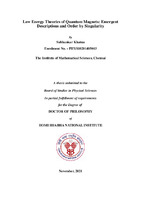Abstract:
This thesis explores the notion of emergence in quantum magnets. Emergence describes
properties of a system that do not resemble the behavior of its microscopic constituents.
We argue that a quantum magnet at low energies behaves as if it were a particle mov-
ing on an abstract space — an emergent description of the magnet. This space consists
of all classical minimum-energy configurations of the magnet. A striking feature of this
description is that a highly interacting problem reduces to a non-interacting one. Further-
more, we argue that the emergent properties are qualitatively distinct in unfrustrated and
frustrated magnets. For an unfrustrated magnet, the emergent particle is free. That is, the
particle explores every part of the space uniformly. However, in the case of a frustrated
magnet the particle may not move uniformly over the space. The probability of finding
the particle may be unevenly distributed taking different values at different points. In ex-
treme cases, the probability distribution may be sharply peaked such that the particle is
essentially localized at some point. In terms of the physics of the frustrated magnet, this
maps to ordering in a certain classical configuration. This is a consequence of quantum
effects in the magnet. In this thesis, we investigate mechanisms by which such ordering
takes place. We discuss them in the language of the effective particle picture. As ordering
corresponds to localization of the particle, we present two distinct mechanisms that bring
about this localization: a) order by potential: quantum fluctuations generate a potential on
the space where the particle moves. If the potential has a sufficiently deep minimum, the
particle localizes in its vicinity. b) Order by singularity: if the space is self-intersecting
in nature, the particle localizes at the self-intersection point due to bound state formation
— a consequence of quantum interference and geometry of the underlying space. We
explore these ideas in a few magnetic clusters: the symmetric XY quadrumer, the Kitaev
square, the Kitaev tetrahedron, and the one dimensional spin-S Kitaev model.
